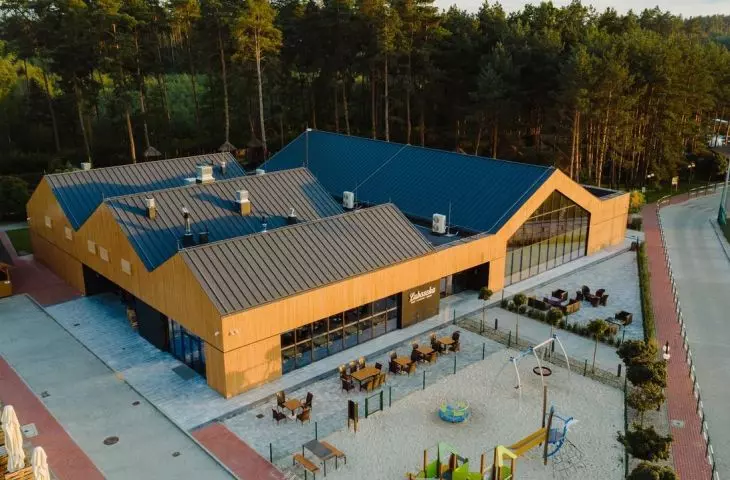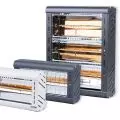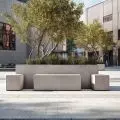In the midst of the picturesque forests of the Sandomierska Forest, a wedding house Lubaszka was created, which stands out from other such facilities. The MEEKO Architekci studio is responsible for the complex design of the building and interior, referring to the nature and rural character of the surroundings. The designers managed to meet the investor's requirements and create a wedding-event facility with a familiar atmosphere, but maintained in modern standards.
Lubaszka was designed in the Rado Resort hotel complex, surrounded by pine forests and mixed forests in Wola Chorzelowska.
Lubaszka seen from a bird's eye view
© MEEKO Architects
timeless modern barn
Designed by MEKKO Architects, the building is a complex of four interconnected modern barns of different sizes. Their size and shape follow the function inside. The barns are covered with gabled roofs finished with seamed metal sheets and are connected to each other by a gentle transition in the form of a flat roof.
Particularly noteworthy are the large-format glazings
photo: Maciej Jeżyk / ONI STUDIO © MEEKO Architekci
The main entrances are accented with dynamic cutouts in the body of the building and contrasting colors. Particularly noteworthy are the large-format glazings revealing the interiors of the main functional parts of the building. From the outside, they lead intuitively to the various parts of the building, while from the inside they allow constant contact with the forest surroundings.
The building can accommodate up to 300 guests, and the banquet hall can be divided into two
© MEEKO Architects
The functional program of the facility includes the main banquet hall - with the possibility to separate two parts, two spacious lobbies, toilet complexes, locker rooms, a children's playroom, a year-round bar, an outdoor grill-bar and full catering facilities to serve the banquet hall. A children's playground and outdoor seating terraces have been designed in front of the facility.
The architecture is reminiscent of a country house
photo: Maciej Jeżyk / ONI STUDIO © MEEKO Architekci
wood, stone, nature
Lubashka can accommodate up to three hundred people for a single celebration. The main banquet hall was designed and built as a multifunctional wooden space that can be adapted to the requirement of different events. In it, the architects have exposed a wooden roof truss, made with glulam technology.
The roof truss was made of glulam wood
Photo: Maciej Jeżyk / ONI STUDIO © MEEKO Architekci
Wooden and stone finishes, combined with large glazing open towards the forest, create a unique atmosphere. Solid wood and metal furniture, industrial lighting and hand-formed tiles add an extra touch.
Metal furniture and industrial lamps introduce industrial accents
Photo: Maciej Jeżyk / ONI STUDIO © MEEKO Architekci
Dobrawa Bies: Lubaszka is a wedding house significantly different from typical venues for weddings and family events - located in a picturesque area and surrounded by forest. From the beginning, you saw that nature would be the main inspiration?
Tomasz Janiec: Even during the first site visit, it was nature that enchanted us the most. The existing trees and the play of light between them build a friendly and relaxing space. The reference to nature was uncompromisingly imposed. The rural character of the place evoked ruralist associations to archetypal homestead buildings and wooden barns. In our design work, we tried to bring out the qualities of the place and create an object that harmonizes rather than competes with its surroundings.
The building is a complex of four interconnected modern barns
Photo: Maciej Jeżyk / ONI STUDIO © MEEKO Architects
Dobrawa: You are responsible not only for the architecture, but also the interiors of Lubaszka. How do you go about working on such a complex project?
Tomasz Janiec: Our task was to develop the construction project, and interior design of the facility dedicated to services related to special events and their service. From the beginning, we knew exactly the functional assumptions of the investor and the requirements from the market. In the design process, we analyzed this type of facility. We drew conclusions as to which venues the clients of our target group choose most readily and in which spaces they feel comfortable. Work on the construction project and interior design took place almost in parallel, which required proper coordination of all branches. Undoubtedly, an important aspect for us was to create an architecture consistent in every dimension. The outside penetrates the inside, and the inside opens up to the outside. A common vision of what we want, how we want to expose it, allowed us to achieve this goal.
The outside penetrates the inside
Photo: Maciej Jeżyk / ONI STUDIO © MEEKO Architekci
Dobrawa: The building consists of four interconnected "modern barns." What is the phenomenon and continuing popularity of this type of building?
Tomasz Janiec: Currently, trends in the spirit of slow life and rustic style are evident in many areas. The barn as an architectural archetype evokes an association with tradition, rural life. The style of such buildings gives a casual feel to the space. This simple form has become an excellent base for the use of modern technologies, finishing materials and unusual combinations of forms.
project genesis
© MEEKO Architects
We constantly refer to the history of the location in our projects. In this case, the barn form was an appropriate spatial solution for a service facility that would fit naturally into the existing context. We decided to build a structure that was divided into four barns to match the scale of the surroundings. The gabled roofs were separated by flat roofs, which add a contemporary touch to the overall architectural form.
year-round bar
Photo: Maciej Jeżyk / ONI STUDIO © MEEKO Architects
Dobrawa: What challenges did you face when designing Lubashka? Do these types of buildings require a different design approach?
Tomasz Janiec: In this type of service buildings, the entire technical and technological infrastructure is very demanding. This is what the recipient doesn't see, and all of this affects the proper functioning of the facility. It was also a challenge to fit the entire functional program imposed by the investor into a certain usable area, as well as to ensure the possibility of simultaneous operation of several events. When designing service buildings, we always give priority to comfort and safety of use. Another important aspect is the aesthetics of the building and landscaping elements. The choice of materials, their type and quality, have an impact on how the architecture presents itself despite the passage of years.
Dobrawa: Thank you for the conversation




























































































